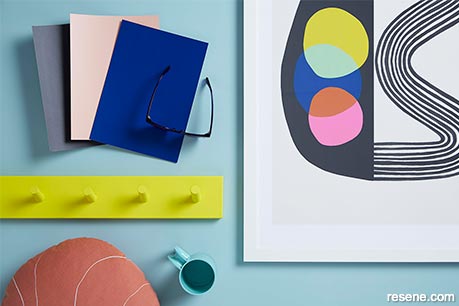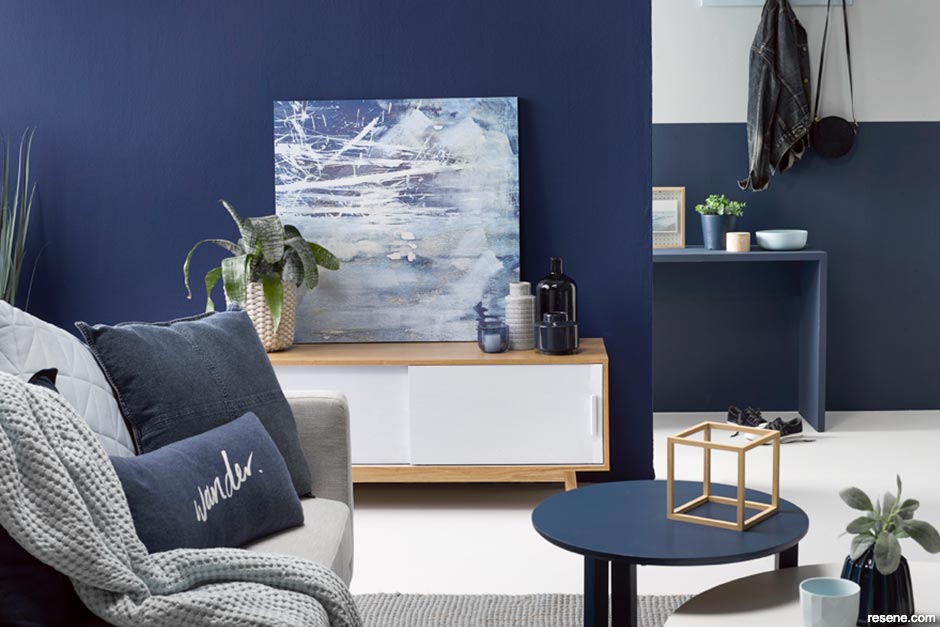From the Resene decorating blog
If your home feels disjointed, chances are you might unknowingly be making one of these common colour mistakes.
If you have ever had a wander around a show home, you might have been impressed by how put together everything looked. Each room probably had a certain something that made it feel as though it fit in with the rest of the house.

Use a piece of statement artwork to define the palette and style for your home.
The Resene Nocturnal wall at the left provides a neutral backdrop for the range of colours and is joined by a side wall in Resene Ashanti and a plywood floor finished in Resene Colorwood Whitewash. A retro sideboard has been given an eye-catching overhaul in Resene Space Cadet and Resene Gorse while the second-hand coffee tables are in the softer Resene Sakura and Resene Ashanti.

A master mood board will help you to make a cohesive plan. The background is in Resene Ashanti, the hooks are in Resene Gorse, and the A4 drawdown paint swatches, from left to right, are in Resene Nocturnal, Resene Sakura and Resene Space Cadet. Project by Kate Alexander, image by Bryce Carleton.
But many real homes just don't feel like this: they come across as unfinished or might have a mishmash of items and rooms that don't really go together, and you could be left wondering what these show homes have that your own home lacks.
If your home feels disjointed, chances are you might unknowingly be making one of these common colour mistakes.
Today, you might be decorating a bedroom. Next month, maybe you turn your attention to the living room. This stop-and-start approach seldom results in a cohesive look.
Does this mean that you have to decorate your whole home at once? Not unless you want to and have the budget for it – but if you want a cohesive look, you do need to come up with a plan for your whole home at once.
Show home designers start by creating a whole-home plan and a master mood board, which lays out the colours, fabrics and finishes to be used throughout the home and within each room. By selecting your Resene colours, furniture, fabrics and accessories, you will be limited to what you can include. This might not sound like a good idea, but in fact, it actually makes it easier to shop once you restrict the options. Rather than just buying whatever catches your eye, purchases have to fit in with your whole home plan.
Blue for the bedroom, red for the dining room, green for the bathroom, yellow for the kitchen – we’ve all been in a home like this. Generally the approach of choosing a completely different hue from room to room stems from a fear of being boring.

Now, this doesn't mean that you have to paint every wall the same colour in your home; it means that you use colour consistently throughout your home. Professional interior designers know that having a consistent Resene colour scheme throughout your house creates cohesion and unity. The colours don't have to be identical; but by using similar colours in different ways, each room will looks as though it belongs in the same home.
Think of it as choosing colour palettes for individual rooms whereas you’re looking for an overall colour personality for the home. A colour personality could should include colours that tell a similar story. For example, an artsy home could have a vibrant jewel toned colour personality, but while the kitchen could feature cobalt blue tiles, the dining room could sport a pair of fuchsia dining benches. A villa could have a soft washed colour personality and have a blush pink console with birch stools in the entry and celadon cabinets with white honed counters in the master bath.
To make sure that your rooms flow from one into the other, consider how much of each room you can see from adjoining rooms, and make sure that the flooring, colour scheme and fabrics flow well between them. This is especially true of entranceways. If you can see several rooms when you enter your home, you will need to make sure that each is cohesive with the décor of the entrance, as well as with each other.

If you want your home to look cohesive, avoid experimenting with different styles in different rooms. Going Scandi in the bedroom, Country in the kitchen and Glam in the lounge. That's the fastest route to having a home look like a jumbled mess with a mish-mash of items that just don't go together, even if you quite like the individual rooms.
The key is to figure out what you’re are drawn to the most with Resene colour, pattern, decorative objects and art and then find the thread the ties them together. Whether you like traditional, modern, eclectic, rustic, shabby-chic, contemporary, coastal or a combination of two – once you have named your style and know what it is you like about it, it will be easier to keep to a coherent look throughout the home.
In the same way that you need to unify colours across a home, make sure that you consider the fabrics and patterns that you use too. Collect swatches of all the fabrics you will use in your home and lay them side-by-side to see how they work together.
Don’t forget about your flooring either. If you have a mix of tiles, wood and carpet across your rooms, it will likely look disjointed. This doesn't mean that you have to have exactly the same flooring throughout your home – although that can be one solution – but you should consider the colour and tone of the flooring. If choose a pale timber, pick a pale carpet and pale tiles – or stick to all darks.
You may think that if you’ve used the exact same colour throughout every room in your home, you’d have employed a fool-proof solution to ensuring continuity in your home – but that might not be the case.
In the most well-designed homes, masterful colour consultants work their unique brand of magic by looking to the lighting to define each of their selections. They may even go so far as to pick a different colour for a single wall because of how much the lighting can change the way it appears within the space. While the swatches may look the same completely different when they’re laying side-by-side, they can look like the same colour used on different walls of the same room because of the way the light hits it.
The beauty of paint is that you can use it to change the colour of nearly anything.
Avoid buying something you don’t like just because it ‘matches’. It’s better to have a half-empty room waiting for something you love than filling it with items you don’t like.
You can still have a cohesive space with a mixture of old and new by balancing antiques with more modern pieces that they have something in common with, like basic shape, scale or colour. If you find something old that you like that has seen better days, a fresh coat of paint might be all it needs to bring it back to life and make it fit with the rest of your home.
Avoid purchasing sets of furniture. It’s much more interesting to have a mix within the same general style, and it will still be cohesive if you repeat it in every room.
Defining your Resene colour palette with one great piece of statement art or patterned wallpaper hung in a prominent common area, like the entryway or lounge. Look to that piece to define your colour scheme, then each room can have varying versions of those hues without feeling disconnected.
Take a tactile approach by carrying the same texture, such a sisal or velvet, throughout each room of your home. While the effects might seem more subliminal, it will satisfy an innate sense of order while also conveying cosiness.
June 17, 2019
Visit your local Resene ColorShop for more colour ideas and all the expert advice and products you need for a superb finish on all your decorating projects.
Book a colour consult | Ask a Colour Expert | Ask a Paint Expert
Resene's decorating blog
Paint your home beautiful! Discover the latest decorating trends, tips and colour news.
![]()
Previous «
Classic colour combos for looks that last
![]()
Blog home
View the latest trends, tips and news
![]()
» Next
Making a media room